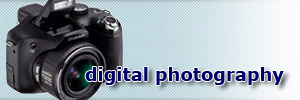
| BUY |
|
| ADVICE | ||||||||||||
|
||||||||||||
| OTHER SITES |
|
Quick-start Guide
Getting you started: from opening the box to first click.
 So now you've bought your brand-new digital camera
and can't wait to get going. Obviously you'll need to read the manual
to learn to use the full range of controls and features, but first here's
a quick guide to get you started.
So now you've bought your brand-new digital camera
and can't wait to get going. Obviously you'll need to read the manual
to learn to use the full range of controls and features, but first here's
a quick guide to get you started.
Most manuals, or a separate sheet in the box will have a contents list. Have look for this and make sure that everything you have paid for is present and correct. In addition to the camera itself, you are likely to find batteries and a charger, a memory card, a computer cable, and one or more CDs or DVDs with software.
Before you start here is a useful tip. Have a book of small-sized post-it notes to use as bookmarks until you are more familiar with the camera. They won't fall out and you can leave a section sticking out and label it with the item it is marking. Many manuals, unfortunately, are badly indexed and this will save you a little time in finding things again..
![]() BATTERIES
BATTERIES
It is in the nature of rechargeable batteries that they are delivered
uncharged, and need a full charge before being used. Skimp on this and
you will lose capacity. See to this first. It is probable that your camera
uses a common size of battery and you may already have some rechargeables
or ordinary dry-cells which can be used in the meantime.
![]() MEMORY CARD
MEMORY CARD
The memory card needs to be inserted in the camera, and it may have
to be formatted so that the camera recognises it. This is very straightforward
and usually the camera will do virtually everything for you and you
just click 'ok'.
![]() ON/OFF switch
ON/OFF switch
Digital cameras vary in the time it can take from switch-on to readiness,
sometimes as long as ten seconds. Remembering to switch off your camera
is important, even though most will do so automatically after a time
interval if not used. While the camera is on, the battery is being drained.
Most will close down automatically to save power and you need to know
how to re-activate. You might also find that you can alter the time
of inactivity before it switches off. First though, find the switch,
turn it on and watch for signs of life.
![]() MENUS
MENUS
![]() Most
setting up and other settings are handled through a four-way rocker switch.
Up and down will go through the menu and left and right into other sub-menus.
Use the default setting for your first few trial snaps, then explore the
options as you go through your results.
Most
setting up and other settings are handled through a four-way rocker switch.
Up and down will go through the menu and left and right into other sub-menus.
Use the default setting for your first few trial snaps, then explore the
options as you go through your results.
![]() MODE
MODE
Check the modes available on your camera. There will, at the very least
be one for taking the picture, and one for viewing it. Put the camera
into photo mode and for now, switch everything else to automatic. Later,
you can explore all of the options available on your camera to get the
best from it.
![]() DISPLAY SCREEN
DISPLAY SCREEN
Digital cameras usually have an LCD screen which is used to display
the image you will photograph. There may well be a viewfinder as well,
and a system of switching one or both on and off. Many people prefer
the LCD screen but it is a great gobbler of battery power and you should
keep it off whenever possible.
![]() DATE & TIME
DATE & TIME
Although not strictly necessary for your first snapshots, the facility
for recording date and time is very useful for later cataloguing of
your photographs. You might just as well set it now and forget about
it.
Similarly, unless you camera is very basic, there will be choices of picture quality. There's no need to take high resolution photographs if you are only going to email them or print postcard-size snapshots and conversely, you won't get a 10 x 8 exhibition print from a low-res picture. Setting a low-resolution (e.g. 640 x 480) will give your camera a quick recovery time and will record the maximum number of pictures on your memory card.
![]() VIEWING
VIEWING
Once the photograph is taken you will be able to view it on the built-in
LCD screen Switch from photo mode to view mode, and you can view your
pictures in sequence (often you can split the screen and view four or
nine at a time). At this point you can also delete unwanted pictures
but don't be too hasty because the LCD screen will not show your photographs
at their best, and anyway, most common faults can be corrected much
easier in digital photography.
You will find that even a modest digital camera will have a whole host of other options for you to explore, but these few will get you going.
![]() Click [
here ] to email
Click [
here ] to email